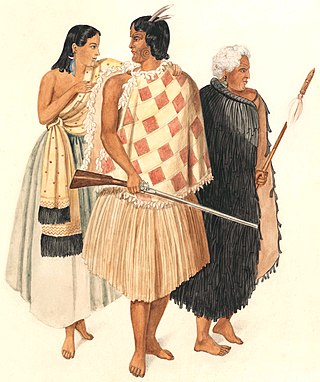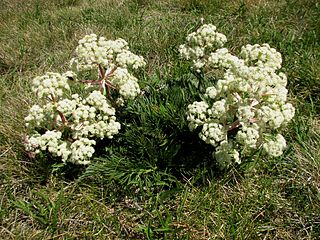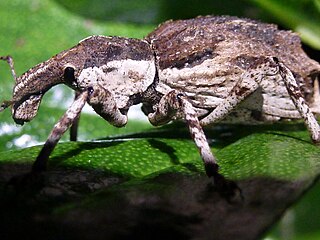
New Zealand flax describes the common New Zealand perennial plants Phormium tenax and Phormium colensoi, known by the Māori names harakeke and wharariki respectively. Although given the common name 'flax' they are quite distinct from the Northern Hemisphere plant known as flax .

The South Island takahē is a flightless swamphen indigenous to New Zealand and the largest living member of the rail family. It is often known by the abbreviated name takahē, which it shares with the recently extinct North Island takahē. The two takahē species are also known as notornis.

Mana Island is the smaller of two islands that lie off the southwest coast of the North Island of New Zealand. The name of the Island is an abbreviation of the Maori name Te Mana o Kupe, which means "The Mana of Kupe".

Aciphylla is a genus of about 40 species of herbaceous plants in the family Apiaceae, all but two of them endemic to New Zealand. They range from small cushion plants to tall flower spikes surrounded by rosettes of stiff, pointed leaves, the latter probably adaptations to prevent browsing by moa. Their common name is speargrass or Spaniard. Most Aciphylla species live in subalpine or alpine habitats in the South Island. Fragrant oil extracted from some large species, known as taramea, is still used as a perfume by Māori.

Dracophyllum is a genus of plants belonging to the family Ericaceae, formerly Epacridaceae. There are 61 species in the genus, mostly shrubs, but also cushion plants and trees, found in New Zealand, Australia, Lord Howe Island and New Caledonia. The name Dracophyllum, meaning dragon-leaf, refers to their strong outward similarity to the unrelated Dracaena, sometimes known as dragon tree. Although dicotyledonous, they resemble primitive monocots with their slender leaves concentrated in clumps at the ends of the branches; they are sometimes called grass-trees.

Phormium colensoi, also called mountain flax, or wharariki in Māori, is a perennial plant that is endemic to New Zealand. The greenish, yellow or orange flowers are followed by twisted seed pods. It is less common than the other Phormium species, P. tenax or harakeke. Mountain flax is also called whararipi, whatariki, mangaeka, kōrari tuauru, wauraki, coastal flax, hill flax and lesser New Zealand flax.

Māori traditional textiles are the indigenous textiles of the Māori people of New Zealand. The organisation Te Roopu Raranga Whatu o Aotearoa, the national Māori weavers' collective, aims to preserve and foster the skills of making and using these materials.

Phormium tenax is an evergreen perennial plant native to New Zealand and Norfolk Island that is an important fibre plant and a popular ornamental plant. The plant grows as a clump of long, straplike leaves, up to two metres long, from which arises a much taller flowering shoot, with dramatic yellow or red flowers.

Anagotus stephenensis, commonly known as the ngaio weevil, is a large flightless weevil that is only found on Stephens Island in New Zealand. The ngaio weevil was discovered in 1916 by A.C. O'Connor on Stephens Island. Thomas Broun described it in 1921 as Phaeophanus oconnori after its collector. The weevils were observed at the time to be 'feeding on tall fescue and the leaves of trees'.

Phormium is a genus of two plant species in the family Asphodelaceae. One species is endemic to New Zealand and the other is native to New Zealand and Norfolk Island. The two species are widely known in New Zealand as flax or their Māori names wharariki and harakeke respectively, and elsewhere as New Zealand flax or flax lily, but they are not closely related to the Northern Hemisphere's flax, which is native to the region extending from the eastern Mediterranean to India and has been used by humans since 30,000 B.C.

Aciphylla aurea, known as taramea in Māori and golden speargrass or golden Spaniard in New Zealand English, is a large, spiky, tufted plant with sharp yellowish-green leaves in the speargrass genus Aciphylla. A. aurea is found throughout the South Island of New Zealand in montane to low alpine habitats.

Ichneutica blenheimensis is a species of moth in the family Noctuidae. It is endemic to New Zealand and is found throughout the North, South and the Stewart Islands. This species appears to prefer drier eastern localities and is rarely collected in western North Island forested areas. It does not appear to be frequently collected in inland dry tussock grassland habitats. The host plant for the larvae of this species is likely to be the golden sand sedge pīngao which is now absent from the moths type locality. However Chappell has raised very young larvae on grass species and the more developed larvae consumed Phormium tenax. Adults are on the wing from November to March and are attracted to both light and sugar traps. The blackish forewing fringes are diagnostic of this species. But worn specimens of I. arotis can be confused with worn specimens of I. blenheimensis. However I. arotis can be distinguished from I. blenheimensis as it has a scale-tuft on the thorax and dark longitudinal stripes on the tegula. This species is classified as "At Risk, Naturally Uncommon" by the Department of Conservation.

Ichneutica steropastis, or the flax notcher moth, is a species of moth in the family Noctuidae. It is endemic to New Zealand and can be found throughout the country from the Three Kings Islands to Stewart Island as well as in the Chatham Islands. The larvae of this species feed on a variety of native and introduced plants however the New Zealand flax is one of the more well known host plants for the larvae of this moth. The larvae are nocturnal, hiding away in the base of the plants and coming out to feed at night. They create a distinctive notch in the leaf when they feed. The adults of this species are on the wing from October to March. Although adult specimens of I. steropastis are relatively easy to recognise they might possibly be confused with I. inscripta, I. theobroma or with darker forms of I. arotis. However I. steropastis can be distinguished as it has a long dark basal forewing streak that these three species lack.

Anthony Hume Whitaker was a New Zealand herpetologist, contributing a 50-year career of fieldwork, pioneering research and species discoveries. His is still the largest collection of reptile and amphibian specimens donated to Museum of New Zealand Te Papa Tongarewa.

Turbott's weevil is a weevil that is endemic to New Zealand. It has been found on the Hen and Chicken Islands, the Poor Knights Islands and the Three Kings Islands.

Hadramphus spinipennis, commonly called the coxella weevil, is a large, nocturnal, flightless weevil only found on Mangere and Rangatira Islands in the Chatham Islands, New Zealand.

Lyperobius huttoni is a New Zealand weevil found in alpine areas of the South Island and at sea level around the Wellington coast. It feeds only on speargrass (Aciphylla). Weevils from the endangered Wellington population have been translocated to predator-free Mana Island.

The New Zealand Department of Conservation has introduced a number of animal and plant species to Mana Island, near Porirua, New Zealand, as part of an ecological restoration programme since taking over conservation management of the island in 1987. Some were reintroductions of species wiped out during years of agricultural use or the subsequent explosion in the number of house mice on the island. A pest control programme eliminated the mice by 1990 and many species have been introduced since. Notable successes include the spotted skink, Duvaucel's gecko and the flax weevil, which are now regarded as well established, and the yellow-crowned parakeet, which has been described as abundant and widespread. Attempts have been made to introduce several seabird species in what the Department of Conservation describes as "the world's most complex seabird translocation project"; results have been mixed.

Mentha cunninghamii, known commonly as New Zealand mint or Māori mint, is a species within the Mentha (mint) genus, endemic to New Zealand.

Dracophyllum fiordense, commonly known as the Fiordland grass tree, is a species of tree or shrub in the heath family, Ericaceae. It is endemic to the South Island of New Zealand. It reaches a height of 1.5–5.0 metres and has tufts of long green leaves at the ends of its branches. Each leaf has a distinctive curled spiral tip. D. fiordense has a pyramid-shaped inflorescence hidden under each clump of leaves, with between 113 and 120 pink flowers on each spike, and later reddish-brown dry fruit; both are around just 2 by 2 mm. It inhabits shrubland, lowland and subalpine forests, and tussock grassland of mountain slopes, gullies, and ridges. Its range covers two main areas: one in Fiordland National Park, and one in the Mount Cook and Westland National Parks.






















